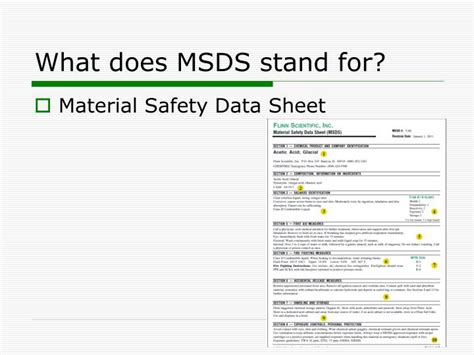Msds Stands For

Msds stands for Material Safety Data Sheet, which is a document that provides information on the safe handling, use, storage, and disposal of a chemical product. It is an essential component of workplace safety and is typically provided by the manufacturer or supplier of the chemical. The MSDS contains detailed information about the chemical's properties, hazards, and emergency procedures, as well as recommendations for personal protective equipment, ventilation, and spill response.
Importance of MSDS in Workplace Safety

The MSDS plays a critical role in ensuring the safety and health of workers who handle chemicals in the workplace. By providing detailed information about the chemical’s hazards and safe handling procedures, the MSDS helps employers and employees to take necessary precautions to prevent accidents and minimize exposure to harmful substances. The MSDS is also an essential tool for emergency responders, such as firefighters and paramedics, who may need to respond to chemical spills or releases.
Key Components of an MSDS
A typical MSDS includes the following information:
- Chemical identification and properties
- Hazards and risks associated with the chemical
- Safe handling and storage procedures
- Personal protective equipment recommendations
- Emergency procedures, including spill response and first aid
- Disposal considerations and regulatory information
The MSDS is usually presented in a standardized format, which makes it easier for users to find and understand the information they need. The format typically includes sections on chemical identification, hazards, safe handling, and emergency procedures, as well as appendices with additional information and references.
Key Points
- MSDS stands for Material Safety Data Sheet
- MSDS provides information on safe handling, use, storage, and disposal of chemicals
- MSDS is essential for workplace safety and emergency response
- MSDS includes information on chemical properties, hazards, and safe handling procedures
- MSDS is typically provided by the manufacturer or supplier of the chemical
Evolution of MSDS to SDS

In 2012, the Occupational Safety and Health Administration (OSHA) adopted the Globally Harmonized System of Classification and Labeling of Chemicals (GHS), which replaced the traditional MSDS with a new document called the Safety Data Sheet (SDS). The SDS is similar to the MSDS but includes additional information and follows a standardized format. The SDS is now the standard document for providing information on chemical safety and is used in many countries around the world.
The transition from MSDS to SDS has improved the consistency and clarity of chemical safety information, making it easier for workers and employers to understand the hazards and safe handling procedures for chemicals. The SDS also includes more detailed information on chemical classification, labeling, and packaging, which helps to ensure that chemicals are handled and stored safely.
| Category | Description |
|---|---|
| Chemical Identification | Information on the chemical's name, synonyms, and identification numbers |
| Hazards | Information on the chemical's hazards, including toxicity, flammability, and reactivity |
| Safe Handling | Information on safe handling procedures, including personal protective equipment and ventilation requirements |
| Emergency Procedures | Information on emergency procedures, including spill response, first aid, and fire fighting |

FAQs
What is the main difference between an MSDS and an SDS?
+The main difference between an MSDS and an SDS is the format and content. The SDS follows a standardized format and includes more detailed information on chemical classification, labeling, and packaging.
Why is it essential to have an SDS for chemicals in the workplace?
+Having an SDS for chemicals in the workplace is essential because it provides workers and employers with critical information on safe handling procedures, hazards, and emergency procedures, which helps to minimize the risks associated with chemical handling.
How often should SDSs be updated?
+SDSs should be updated whenever there is a change in the chemical’s composition, hazards, or safe handling procedures. Employers should also review and update their SDSs regularly to ensure that they have the most current information.
In conclusion, the MSDS, now replaced by the SDS, is a critical document that provides essential information on chemical safety. By understanding the importance of the SDS and staying up-to-date with the latest regulations and standards, employers and workers can minimize the risks associated with chemical handling and ensure a safe working environment.
Related Terms:
- Safety data sheet
- MSDS stands for medical
- MSDS 16 points
- MSDS for chemicals
- What is MSDS used for
- MSDs stands for musculoskeletal disorders
